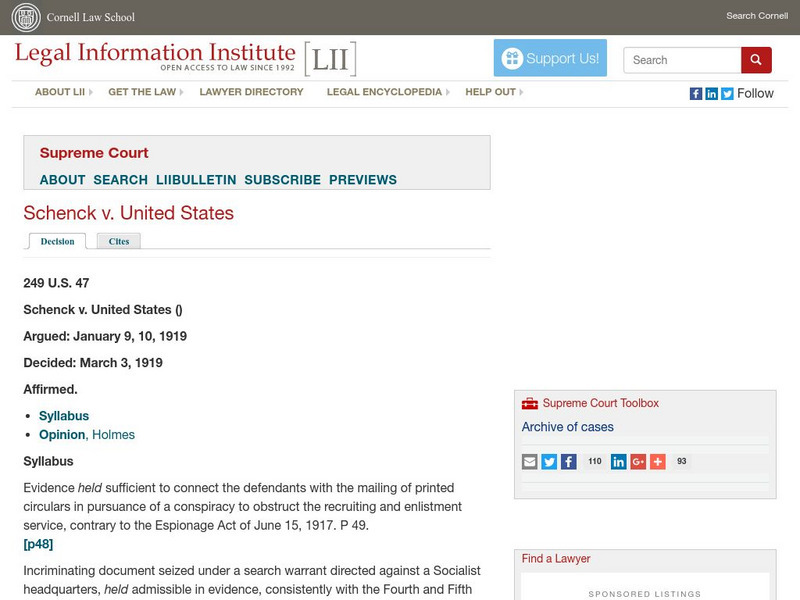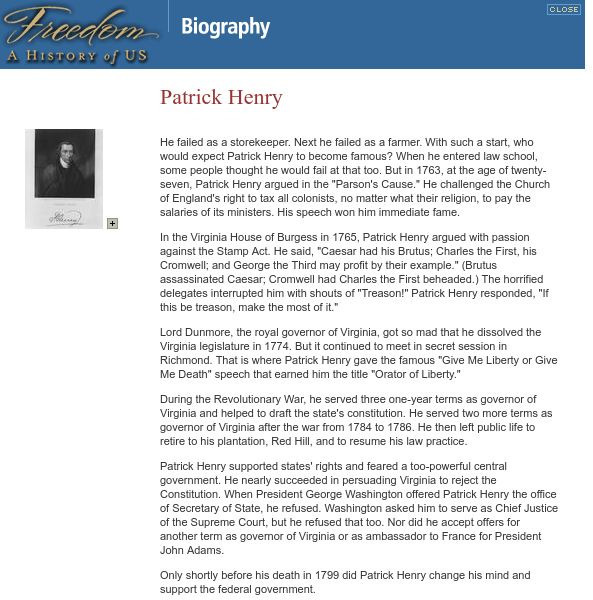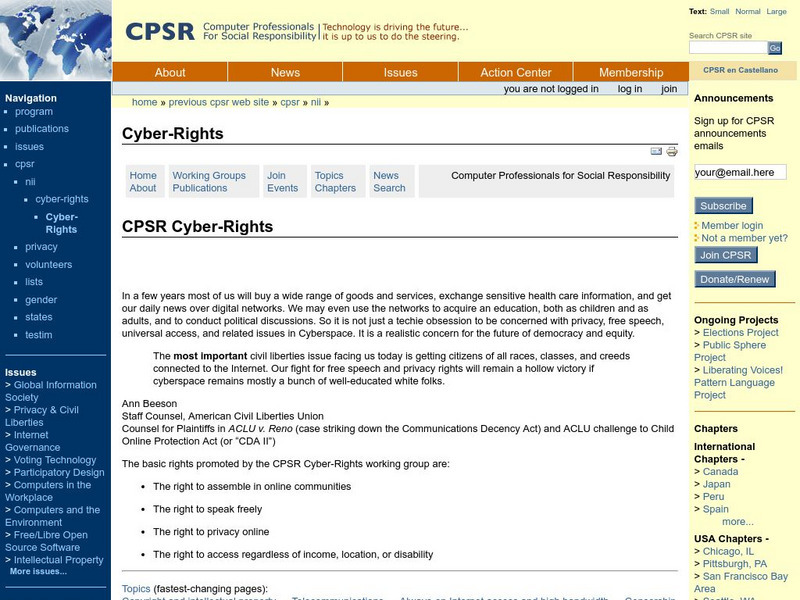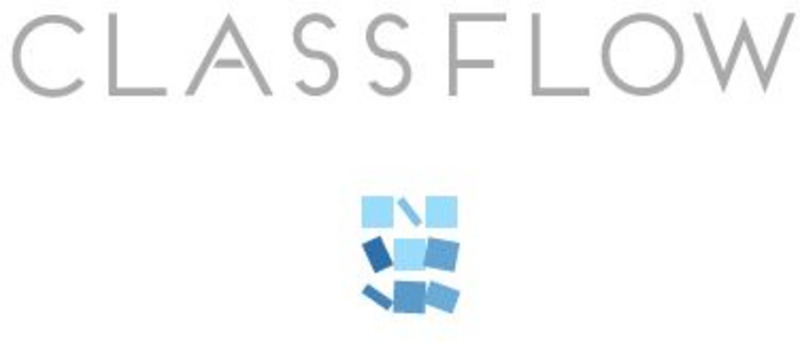Digital History
Digital History: Religion and the u.s. Constitution
A very brief explanation of the three-pronged test the Supreme Court uses to determine the constitutionality of a governmental poiicy to ensure it doesn't advocate the establishing of religion.
Wyzant
Wyzant: March on Washington for Jobs and Freedom
Lesson briefly describes the March on Washington for Jobs and Freedom and includes links to recordings of the speeches made by prominent Civil Rights Leaders on that day.
US National Archives
Nara: Charters of Freedom
National Archives exhibit presents selected pages of George Bush's State of the Union Address given January 31, 1990. Includes introductory essay on freedom.
Independence Hall Association
U.s. History: The Arsenal of Democracy
Although Americans remained isolationist in their thinking, President Roosevelt understood that the European allies needed help against the Germans. Read about the incremental ways America became involved in World War II in Europe...
Other
Freedom Forum: What Is the Fighting Words Doctrine?
A good summary of the "Fighting Words Doctrine" which was first articulated in the Supreme Court Case of Chaplinsky v. New Hampshire. Contains links to case summaries.
C-SPAN
C Span American Writers: Narrative of Frederick Douglass
A brief summary of The Narrative of the Life of Frederick Douglass. Also includes an on-line text of the work as well as links to other informational websites.
PBS
Wnet: Thirteen: A War to End Slavery: John Wilkes Booth and Assassination of Lincoln
A lesson plan from the producers of the 16-episode PBS series "Freedom: A History of US" that examines the factors that led John Wilkes Booth to assassinate President Lincoln. Also involves comparing and contrasting Lincoln's and Andrew...
Massachusetts Institute of Technology
Mit: The Tech: Cnn Foils Prior Restraint
An essay by a freshman at MIT gives a definition and examples of "Prior Restraint." The Tech is the MIT school newspaper. (Published Dec. 7, 1990)
Cornell University
Cornell University: Law School: Schenck v. United States (1919)
Features a syllabus of the landmark Supreme Court case of Schenck v. United States which decided that the defendant's right to criticize the draft was not protected by the First Amendment.
Claremont Institute
Founding.com: Calvin Coolidge
Two speeches given by Calvin Coolidge. The first was in 1924 on the topic of religious freedom. The second was in 1926 to celebrate the 150th anniversary of the Declaration of Independence.
National Endowment for the Humanities
Neh: Edsit Ement: The First Amendment
This resource presents lessons on the First Amendment. It contains many resources for use with children, and links to primary source documents.
Reporters Committee for Freedom of the Press
Rcfp: Court Rescinds Its Own Prior Restraint Against the Ap
A judge decided not to continue to enforce a prior restraint keeping the Associated Press from releasing information it had obtained through an open records request.
US National Archives
Nara: Teaching With Documents: United States vs. Thomas Cooper
The information, documents and lessons relating to the United States vs. Thomas Cooper case. National Archives and Records Administration (NARA).
Wikimedia
Wikipedia: Defamation
Learn what defamation is, and explore the legal differences between slander and libel. Other concepts include "false light" and "absolute privilege." Also looks at legal defenses used and defamation laws in other countries.
PBS
Wnet: Thirteen: Freedom: A History of Us: Webisode 14: Let Freedom Ring
Series episode covers the civil rights movement and the struggle for equality in post-World War II America.
ClassFlow
Class Flow: Gettysburg Address
[Free Registration/Login Required] Students analyze historical speeches by Abraham Lincoln and Martin Luther King to find rhetorical devices and features that make these speeches memorable.
PBS
Wnet: Thirteen: Freedom: A History of Us: Patrick Henry
This site provides a biography of Patrick Henry, highlighting his public speaking abilities and famous speeches.
Boston College
Boston College: Branzburg v. Hayes
Full decision from the Branzburg v. Hayes United States Supreme Court case.
The History Cat
The History Cat: u.s. History: The Civil Rights Movement
Outlines Martin Luther King, Jr.'s work as a civil rights leader from the beginning of the Montgomery Bus Boycott in 1955 up until his assassination in Memphis on April 4, 1968. Describes the different protest movements, including the...
Other
Cpsr: Cyber Rights
CPSR offers an informative discussion of current legal and policy topics hosted by group working for rights of assembly and speech for online communities.
CommonLit
Common Lit: Text Sets: Argument, Bias, and Persuasion
Collection of 43 Grade-Leveled texts (6-12)on the topic Argument, Bias, and Persuasion. Have students track arguments through texts as they examine logical reasoning, bias, and persuasive techniques such as emotional appeals, character...
Other
The Oas and the Inter American System
This site on the The OAS and the Inter-American System provides history, key dates, original and current member states, past and present secretaries general, and more.
ClassFlow
Class Flow: Civil Rights Movement
[Free Registration/Login Required] Through this lesson, students identify individual, personal, and political rights (freedom of religion, freedom of speech, right to own property) by analyzing lives of historical African American...
CommonLit
Common Lit: "I Have a Dream" by Dr. Martin Luther King, Jr.
King delivered his "I Have a Dream" speech to over 250,000 people from the steps of the Lincoln Memorial in Washington, D.C., during the March on Washington for Jobs and Freedom on August 28, 1963. In this speech, King discusses racial...
Other popular searches
- Journalism Freedom of Speech
- Censorship Freedom of Speech
- Freedom of Speech Obama
- Canadian Freedom of Speech
- Freedom of Speech Music
- Freedom of Speech Readings
- Limited Freedom of Speech
- Freedom of Speech Abm
- Freedom of Speech and Press














